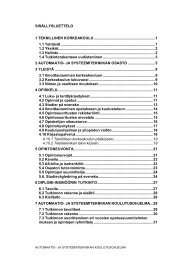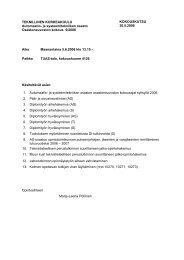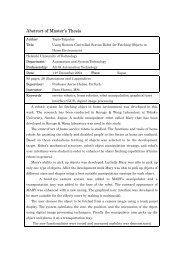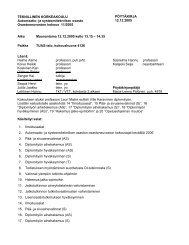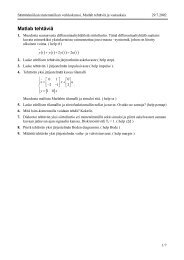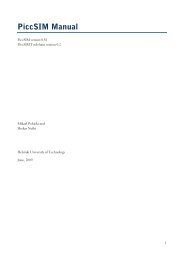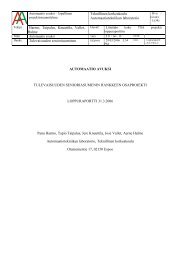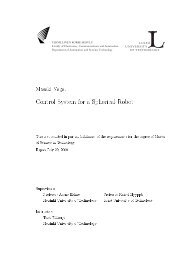fem modelling of a bellows and a bellows- based micromanipulator
fem modelling of a bellows and a bellows- based micromanipulator
fem modelling of a bellows and a bellows- based micromanipulator
You also want an ePaper? Increase the reach of your titles
YUMPU automatically turns print PDFs into web optimized ePapers that Google loves.
FEM <strong>modelling</strong> <strong>of</strong> a <strong>bellows</strong> <strong>and</strong> a <strong>bellows</strong>-<strong>based</strong> <strong>micromanipulator</strong>III. ModellingThe 3D model is axisymmetric, but all the loads to be applied are not. It means the 2D finiteelements have to h<strong>and</strong>le axisymmetric boundary conditions, but the bending behaviour <strong>of</strong> the<strong>bellows</strong> having also to be simulated, the element should as well manage non-axisymmetricloads.θθFigure 9An eight-node axisymmetric element, thatappears usually only as a two-dimensionalelement in representations. What appears to benodal points are actually nodal circles.Except for having to account for circumferential strain, axisymmetric elements are verysimilar to plane elements. A special class <strong>of</strong> ANSYS ® axisymmetric elements – calledharmonic elements – allows a non-axisymmetric load. For these elements, the load is definedas a series <strong>of</strong> harmonic functions – Fourier series. For example, a load F is given by:F(θ) = A 0 + A 1·cos(θ) + B 1·sin(θ) + A 2·cos(2θ) +B 2·sin(2θ) + … (3.1)Each term <strong>of</strong> the above series must be defined as a separate load step. A term is defined bythe load coefficient, A x or B x , the number <strong>of</strong> harmonic waves x <strong>and</strong> the symmetry condition,cos(xθ) or sin(xθ). θ is the circumferential coordinate implied in the model. The loadcoefficient is determined from the st<strong>and</strong>ard boundary condition input. The input value forforce should be a number equal to the peak value per length-unit times the circumference. Thedeflections <strong>and</strong> stresses are output at the peak value <strong>of</strong> the sinusoidal function. For our model,PLANE83 is used (figure 10).LPY (axial)IX (radial)OMKL,O,KNPNJ I MTriangular optionJFigure 10Representation <strong>of</strong> the twodimensionalelement PLANE83, thathas 8 nodes, one at each corner, I, J,K <strong>and</strong> L, <strong>and</strong> four sidewise, M, N, O<strong>and</strong> P. This element supportsaxisymmetric geometry <strong>and</strong> nonaxisymmetricloads.This element has three degrees <strong>of</strong> freedom per node: translation in the nodal x, y <strong>and</strong> zdirections. These directions correspond respectively to the radial, axial <strong>and</strong> tangentialdirections. It can tolerate irregular shapes without loss <strong>of</strong> accuracy. It has 8 nodes, one at eachcorner <strong>and</strong> one in the middle <strong>of</strong> each side 5 . This element <strong>of</strong> course also accepts axisymmetricloads, <strong>and</strong> will be used for that purpose. But for non-axisymmetric loads, the results given bythis element have to be checked with another 3D element.3.1.3 CHOOSING RIGHT SOLID 3D-ELEMENTThe term “3D solid” is used to mean a three-dimensional solid that is unrestricted withrespect to shape, loading, material properties <strong>and</strong> boundary conditions. A consequence <strong>of</strong> thisgenerality is that all six possible stresses – three normal <strong>and</strong> three shear – must be taken intoaccount. Also the displacement field involves all three possible components, x, y <strong>and</strong> z.Typical finite elements for 3D solids are tetrahedra <strong>and</strong> hexahedra, with three translationaldegrees <strong>of</strong> freedom (DOF) per node.5 For more details about this element, see ANSYS ® Element Manual, chapter 4, section 4.83.13



